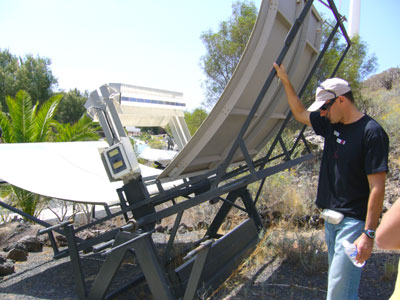The Sun - Renewable Energy with Great Potential
for Latin America and the Caribbean
 |
| Photo: Victor Morell Perez, Flickr |
The energy requirements of Latin American countries increase every year. For Chile alone, demand is expected to increase by 200 MW (mega watts) per year. Economic development and progress require energy, while global warming poses the challenge of generating energy in a sustainable, low-polluting and environmentally friendly way.
In this context, what are known as “non-traditional renewable energy sources”, which include solar, wind and geothermal energy (steam from underground heat), offer great potential for several Latin American and Caribbean countries.
On a visit to Chile two years ago, physics Nobel Prize winner Carlo Rubbia pointed out that innovation, driven by research and development, is the key to finding a solution to the energy problem in general and global warming in particular.
It is therefore vital to introduce greater incentives for the development of renewable energy and move forward with devising policies that promote energy efficiency.
The use of a specific renewable energy source will depend on each country’s particular conditions and the comparative advantages it offers within that territory. For instance, Brazil has great potential for biofuel production; Chile for solar, wind and geothermal energy; Uruguay for wind energy; and Peru and Ecuador for geothermal energy.
ECLAC experts recently took part in the First International Workshop on Solar Energy and its Applications, which was held in Arica, Chile. International experts and authorities in attendance assessed the possibilities offered by solar energy.
According to ECLAC, solar energy is an exceptional way of supplementing oil to generate energy in a way that goes beyond the price and profitability situations relevant for traditional energy sources. Along with other renewable energy sources, solar power is an essential resource for diversifying the energy mix of countries.
The north of Argentina and Chile and the south of Peru and the Plurinational State of Bolivia, for instance, have considerable comparative advantages in the use of solar power, as they have the highest level of direct solar radiation in the world (2,800 kilowatts/hour per m2 per year in the case of the Atacama Desert in Chile).
Other areas conducive to the development of solar power in the region are in Mexico (states of Baja California, Sonora and Chihuahua) and Brazil (the regions of Sobradinho and Januária in the north west).
There are currently three main technologies that use this form of energy: solar thermal power to produce heat for household water; photovoltaic solar power to generate electricity; and thermodynamic or concentrated solar power (CSP) to produce continuous energy using the heat storage system, which makes for a more predictable and long-lasting supply than with photovoltaic energy.
According to ECLAC experts, the third option of thermodynamic or concentrated solar power (CSP) has the advantage of being more flexible, as it can be used in projects of various sizes, from 5 MW to 280 MW, and it also stores the heat needed to produce steam for electricity.
There are currently projects of this type up and running in the United States (California), Spain, North Africa and the Middle East, with over 1,000 MW installed and another 1,000 MW under construction, with operations scheduled to begin by 2012. Over 5,000 MW is expected to be in operation by 2015.
There is a certain paradox, however, in Latin America. While there is certainly consensus on the excellent quality of solar energy and its great potential, no CSP initiative has been developed to date.
Cost is one of the reasons. For example, a planned 50 MW capacity facility in Spain needs around 300 million euros (without heat storage). Although the investment required for this technology is high, it is expected to fall gradually as exploitation techniques improve and a solid national base is built up in each country, with a skilled workforce and a greater level of research and development.
More IN FOCUS
Demand for care is a challenge for social protection systems in
Latin America
Logistical infrastructure of ports could become the
“bottleneck” of Latin American growth
Second seminar on telemedicine held in Venezuela
ECLAC
reveals
offices renovated following the earthquake in 2010
|
“Non-traditional renewable energy sources”, which include solar energy, offer great potential for several Latin American and Caribbean countries. |
|
| Solar energy is an exceptional way of supplementing oil to generate energy in a way that goes beyond the price and profitability situations relevant for traditional energy sources. | |